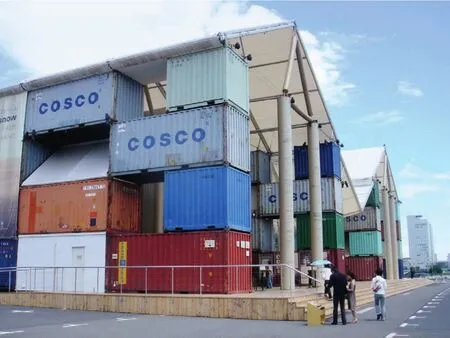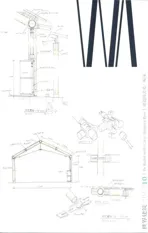论坂茂:用合理的思考开拓建筑的可能性
2014-02-20五十岚太郎TaroIgarashi
五十岚太郎/Taro Igarashi
司马蕾 日译中/Translated from Japanese by SIMA Lei
钱芳 中译英/Translated from Chinese by QIAN Fang
许懋彦 校/Chinese proofread by XU Maoyan
论坂茂:用合理的思考开拓建筑的可能性
五十岚太郎/Taro Igarashi
司马蕾 日译中/Translated from Japanese by SIMA Lei
钱芳 中译英/Translated from Chinese by QIAN Fang
许懋彦 校/Chinese proofread by XU Maoyan
笔者根据自己作为策展人参与了一个展览会的经验,把坂茂建筑师的特点视为跨越建筑的两个领域,即“社会性”与“设计性”。实际上,坂茂至今既追求建筑结构及建筑材料的可能性,又作为支持活动把自己设计的临时住宅等提供给自然灾害的受灾区。本文通过逐一分析几个建筑作品,而试图明确坂茂作为建筑师的特殊性。
坂茂,设计,材料,自然灾害,支持活动,普利茨克建筑奖
社会性与设计感的贯通
最近,笔者作为特邀策展人正在筹划将在金泽21世纪美术馆举办的“日本建筑师专题展”(展览时间为2014年11月1日—2015年5月10日)。该展览也筹划将在法国的蓬皮杜艺术中心同时举办。在展览的第二部分——“3.11之后的建筑师”专题中,将有坂茂的作品展出;而在展览的第一部分——“日本建筑师1945-2010”专题中,也将呈现其作品。在这个新世纪之后、日本国内规模最大的建筑展中,他是为数不多的在展览的第一和第二部分中都有作品展出的建筑师之一,因此更突显出坂茂在建筑界的重要地位。这两部分展览不仅仅是在展出的对象和时代划分上有所不同,同时,第一部分展览的视角更着重于设计的造型方面,第二部分的展览则更侧重设计与社会的关系。而在谈到追求形式感的设计与社会公益性这两个方面时,坂茂的确都在世界范围内饱受赞誉。一般来说,重视造型趣味的建筑师,其作品的社会性通常较为薄弱;相反,强调社会性的建筑师,其作品在形式上往往较为普通。但坂茂并不属于这两种分类中的一类,而是惊人地成功兼具了这两种品质。
首先,坂茂作品的特点无疑体现在各种独特的结构与建造上——由弯曲的合成木材和膜结构组建成屋顶的蓬皮杜梅斯中心(图1)、位于瑞士的木构造建筑,以及灵活使用了独特纸管结构的各种构筑物都体现了这一特质。此外,在1995年的日本阪神大地震、卢旺达大屠杀、中国四川大地震、美国的卡特里娜飓风等灾害发生之后,他都第一时间赶赴世界各地的这些灾区,支援受灾民众和难民们。灾区需要建设具有社会意义的临时住宅,同时也需要与之开发建设相匹配的建造方式和建筑材料。坂茂将这两种需求很好地融合在一起,在灾区开展了许多具有实验性的项目——例如,卢旺达的纸质避难所、阪神大地震后建造的纸质小屋(图2)、四川大地震后在成都建造的纸管临时学校,以及东日本大地震后为遭受海啸袭击的女川地区设计的由集装箱堆叠起来的临时住宅(图3)等等。这些建筑如同博览会上的展馆建筑,正因为都不是永久性建筑,又应对着紧急性的需求,才能让建筑师有机会尝试这些实验性的结构和建造做法。

1 蓬皮杜梅斯中心/Centre Pompidou - Metz
Connection between Social Significance and Sense of Design
As the invited curator, the author is planning a theme exhibition on Japanese architects that will be held at the 21st Century Museum of Contemporary Art, Kanazawa, from November 1, 2014 to May 10, 2015. The exhibition is planned to be held at Center Pompidou in France during the same period of time.The works of Shigeru Ban will be exhibited both in the second section of the exhibition - "Architects after the 3.11 Earthquake" and in the first section -"Japanese Architects 1945 - 2010". He is one of the few architects whose works are presented in both sections of this biggest architecture exhibition in Japan since the beginning of the new century, by which his unique position in the field is reflected. In fact, besides the differences in targets and time between the two sections of the exhibition, the first section highlights the form of designs while the second section lays more emphasis on the relationship between design and society. And Shigeru Ban has been widely recognized in the world for both his formal designs and concerns on social welfare. Generally speaking, architects who emphasize visual effects are weak in social considerations. On the contrary, those who focus on social values tend to create forms that are plain and uninteresting. Shigeru Ban belongs to neither group. He is surprisingly competent in both aspects.
First of all, when we talk about the features of Ban's works, the unique structure and way of construction will undoubtedly come into our mind. These features are also emphasized by Centre Pompidou-Metz (fig.1), a wooden structure located in Switzerland, whose roof is formed by curved laminated wood and membrane, as well as by other architectures of flexible paper-tube structure. What's more, Ban would respond immediately and go to help victims and refugees in areas stricken by natural or social disaster such as the Hanshin earthquake in 1995, the Rwanda massacre, the Sichuan earthquake in China, and the Hurricane Katrina in the US. Temporary residential housing of social significance is always needed in disaster stricken areas, so is the development of corresponding construction method and materials. Ban achieved a balance between these demands. He carried out many experimental projects in these disaster areas, including the paper emergency shelters in Rwanda, the paper houses constructed after the Hanshin earthquake (fig.2), temporary paper-tube school in Chengdu after the Sichuan earthquake, the temporary houses formed by shipping containers in Onagawa after the earthquake and tsunami (fig.3), etc. Like the exhibited buildings in an expo, these architectures, temporary and responding to emergency, provide architects with opportunities to experiment with new structures and construction methods.

2 阪神震灾区纸管临时住宅/Paper Log Houses - Kobe

3 东日本震灾区女川临时住宅/Container Temporary Housing, Onagawa, Japan

4 游牧美术馆/Nomadic Museum Tokyo
普利兹克奖被称为建筑界的诺贝尔奖,自创设以来一直以欧美为中心开展评审。虽然有着这样的历史,近年来,亚洲势力却开始在其中独占鳌头。继2010年的SANAA、2012年的王澍、2013年的伊东丰雄之后,坂茂在2014年获此殊荣。在这几位建筑师中,坂茂是唯一一位在美国的大学接受过专业教育的。他在那里学会了结构、建构的方法、考虑材料的可回收性能、设计可以被清楚解释的造型,以及不被情绪左右、理性的建筑思考等技能,因此从开始就具有了国际视野,并据此开展工作。他现在也总在世界各国间奔走着——翻看他的作品集中2012年之后的作品,就会发现几乎全是国外的项目。他在日本的建筑师中也显得非常独特。轻质明亮的“纸质建筑”总会让人想起,特别是外国人尤感独特的、充满日本风尚的木结构古建筑。采用了革命性木结构的7层高的瑞士Tamedia新总部大厦也是如此。坂茂对纸和木材的执着,以及对可移动的隔断、内部与外部空间之间连续性等问题的思考,都让人想起日本传统建筑体现的品位。但他同时又在其中加入了现代科技的成果,并由此开拓出建筑的全新可能性。
突破常规之明快创意的实现
让我们来分析几座坂茂设计的建筑。
游牧美术馆(2007)以象征游牧民族的游牧为名,展示葛雷哥里·柯北(Gregory Colbert)的摄影作品。美术馆作为临时建筑,在纽约和圣莫妮卡搭建之后,第三站则来到了东京的台场(图4)。152个五彩缤纷的货运集装箱呈棋盘状堆叠在一起,形成凹凸相间的墙体,坡屋顶则以铝制框架为结构,上面包裹着pvc膜。建筑的内部空间中排列着高10m、直径74cm的纸管,形成连续的柱廊。可以说,这座美术馆是由出租的集装箱及坂茂擅长运用的纸管等可回收材料建造而成的。然而,它虽然是座仅仅使用了些工业部件的简单建筑,却因为其内部幽暗的柱廊而形成了神殿般的空间,加之墙上展示的以讴歌壮美自然与人类之间的共鸣为主题的柯北的摄影作品,更突显出庄严的宗教感和空间的趣味性。
同一年,坂茂设计的位于银座的尼可拉斯·海耶克中心(Nicolas G. Hayek Center,2007),则是一座突破常规的商业设施。通常,为了增加营业面积,商场中都会按最小需求设置电梯。然而,坂茂却设置了直接联系各个店铺的7台电梯。此处的电梯空间并不只是为了上下楼层,而是成为商店的一部分——同时被用作陈列商品的展示空间。有趣的电梯设计也成就了崭新的商业空间。可以说,通过对集装箱、电梯等既有要素的重新诠释,坂茂大胆地革新了对“建筑”的定义。
2010年,蓬皮杜艺术中心分馆在法国的梅斯市落成。从上空俯视,可以看到其屋顶呈六角形,由网状的复合木条编织而成。而建筑大幅扭曲的造型也让其成为令人印象深刻的城市新地标。这一设计应该是从坂茂过去参与的汉诺威世博会(2000)日本馆的屋顶设计发展而来的。如帽子般的大屋顶之下,被称为“展管”的高15m、长90m的3条长方形体块交错、层叠在一起;中央则设有一座六角形的电梯塔,将功能空间联系起来。建筑明快的交通流线让人想起坂茂设计的位于银座的大楼。“展管”的端头是玻璃面的大开口,面向着不同方位,将大教堂、中央火车站等城市地标的景致如同画作一般捕捉下来,让人在美术馆内部也能观赏到城市美景。这一让人感慨“原来如此”的明快创意取得了竞赛的优胜,也是坂茂的建筑中集大成的作品。
在世界各受灾地区的工作
因为有了在阪神大地震等灾后工作的经验,在东日本大地震发生之后,坂茂迅速地开展行动,在50个以上的避难所中设置了1800多个(尺寸2m×2m)隔断单元,来保护各个家庭间的基本隐私。在这个过程中,位于崎岖海岸线上的女川町的町长向他诉说了当地的问题,因为平地很少,如建设传统的一层临时住宅,则数量不够。坂茂在听说之后,采用将海上运输用的集装箱堆叠在一起的做法,建成了189套3层临时住宅(其中的一部分为2层)。这种多层集装箱建筑的优点在于所需工期短,同时能够在有限的基地上建设大量住房。同时,由于将集装箱采用棋盘状的方式堆叠,其使用量也比预期减半。在狭窄的集装箱中设置儿童房和一体化卫浴空间,而在相邻集装箱间形成的开放空间的外侧装上通高的玻璃,构成开放的起居空间。虽然借鉴了游牧美术馆的设计手法,但此建筑却可以作为供人长期居住的公寓来使用。
此后,坂茂还被指定为在女川当地的整个复兴计划中非常重要的女川车站的设计师。另外,2011年还发生了新西兰大地震,基督城大教堂在地震中受灾,坂茂为此设计了以纸管和集装箱为材料的临时教堂。这一设计考虑了原有教堂的比例等要素,形成了对原有教堂记忆有所继承的新建筑设计。最近,坂茂还在2013年的菲律宾台风灾害发生后,在当地建设了纸质的小屋和临时教堂。而在2014年8月的广岛泥石流发生之后,他也立刻行动,赶往现场。建筑工程总是牵扯到莫大的费用问题,因此,建筑师也常常成为了专门侍奉有钱人的职业。但是坂茂却总是愿意自发地行动起来,为失去家园的人建造庇护所,而不是建造豪宅。然而,这些建造于极端条件下的建筑原型化的小屋,可能才是所谓的建筑的原点,同时也赋予了我们在当代重新思考建筑的新的可能性的契机。
Regarded as the Nobel Prize in architecture, Pritzker Architecture Prize has been focusing on the works of Western designers since its establishment. But in recent years, Asian architects started to rise in the competition. After SANAA in 2010, Toyo Ito in 2013, and WANG Shu in 2012, Shigeru Ban won the prize in 2014. Among them, Shigeru Ban is the only one who has received professional training in the United States, where he learned how to construct with consideration to the recycling quality of materials, how to make designs that can be interpreted, and how to develop rational thinking that is unaffected by emotions. His education has given him an international perspective, a good starting point for his career. Ban is now working on a world basis - all his works after 2012 are almost foreign projects. He is also very distinctive among Japanese architects. His light and bright "paper structure" easily reminds people, especially foreigners, of the ancient wooden architectures of Japanese flavor, as is the case of the new 7-storey headquarter of Tamedia in Switzerland. Ban's obsession with paper and wood, and his thinking on issues like movable partitions and continuity between interior and exterior space reminds us of the taste displayed in traditional Japanese architectures. At the same time, Ban adds modern technology into his works and hence explores new possible utilization of architecture.
bright Creation That breaks Through Conventions
Now let us analyze several works by Shigeru Ban.
Named after the nomad, the Nomadic Museum in Tokyo (2007) exhibited photographs by Gregory Colbert. As a temporary building, the museum chose Tokyo Odaiba as its third stop (fig.4), after its first two stops in New York and Santa Monica. The architecture is constituted by 152 colorful containers piled one above the other in a checkerboard pattern, which result in walls of concave and convex, and a pitched roof of aluminum framework with PVC membrane cover. In the interior space, the 10m-tall and 74cmdiameter paper tubes form an unbroken colonnade. It can be said that the whole museum is composed of rented containers and recyclable materials, such as paper tubes, the favorite of Shigeru Ban. However, in this plain architecture with limited industrial components, a temple-like space is created by the gloomy interior of the colonnade. In addition, the photographs by Colbert that are well known for exploring the connections between nature and human further enhance the solemn religious atmosphere in the museum and make the space more profoundly interesting.
The other piece of work by Shigeru Ban in the same year, i.e., the Nicolas G. Hayek Center at Ginza, is a non-conventional commercial facility. Normally architects will make a minimal space for lifts in order to increase the shopping area. But Ban designed seven lifts that are directly connected to each store in the center. These lifts, besides their conventional functions, are also used for commodity exhibitions, thus become part of the stores. An innovative commercial space is created through the delightful lift design. It can be said that Shigeru Ban has bravely carried out a revolution on the definition of "architecture" by his new interpretations of the existing architectural elements such as containers and lifts.
In 2010, Centre Pompidou-Metz was established in Metz, France. Viewed from the sky, its roof is formed by laminated wood in a hexagonal woven pattern. The twisted shape of the building has made it an impressive new landmark of the city. The design is probably developed from the roof of the Japan Pavilion that Ban conducted for the Hanover Expo in 2000. Under the huge hat-shaped roof, three "gallery tubes" of intersected cuboids of 90m×15m are stacked one above the other. In the center of the building is a hexagonal lift tower that connects different functional spaces. The succinct lines of passages in the building remind people of Ban's building at Ginza. At the ends of the "gallery tubes" are glass windows facing different directions, so that visitors are able to have good views of the famous landmarks of the city, such as the Cathedral and the Central Station etc. The enlightening design excelled in the competition. It is also regarded as the representative work of Ban.
Works in Disaster-Stricken Areas in the World
With his post-disaster working experiences after the Hanshin Earthquake, Ban immediately responded after the happening of the great earthquake in Eastern Japan. He set up over 1800 (size 2m×2m) isolated units in more than 50 shelters to protect the basic privacy for families. At that time he learned that due to the insufficient amount of flat land, it would be difficult for Onagawa to provide enough temporary housing if the traditional single-story houses were to be built. He then built 189 three-story temporary buildings (some were in two stories) by stacking shipping containers together. Using containers as building units shortened the construction period and allowed more housing in limited land. Meanwhile, when stacked in a checkerboard pattern, the number of containers needed was reduced by half. Kid's rooms and bathrooms are placed in narrow containers, and full height glasses are installed on the exterior sides of neighboring containers, forming open living spaces. Though the design has borrowed something from the Nomadic Museum, the container buildings can be used as permanent apartments.
Shigeru Ban was also appointed as designer of the Onagawa Station, which was an important part of the revival plan of Onagawa. In 2011, New Zealand was hit by a big earthquake that caused damage to the Christchurch Cathedral. Accordingly Shigeru Ban designed a temporary cathedral using paper tubes and containers. By reserving the scale and some other elements of the original cathedral, he created a new cathedral that inherited a memory of the old one. In 2013, after the typhoon in Philippine, Shigeru Ban built paper log houses and temporary church for the local people. And shortly after the occurring of the debris flow in Hiroshima in the August of 2014, he went to the disaster area and took immediate actions. As architectural projects are always related to huge amounts of money, architects are usually regarded as people who serve the rich. However, instead of designing luxurious villas, Shigeru Ban always chooses to act spontaneously and build shelters for people who lost their homes. In fact, these small prototypes of architecture constructed under extreme conditions may be the so-called origin of architecture. They have given us a chance to reconsider new possible utilizations of architecture in our times.
On Shigeru Ban: Exploring the Possibility of Architecture with Rational Thinking
Based on the experience of participating in organizing an exhibition, the author considers Shigeru Ban as an architect that embraces both the "social" and the "structural" aspects of architecture. In fact, what Shigeru Ban pursues hitherto is not only the possible utilization of architectural structure and building materials, but also, as an additional contribution, his design of temporary houses for disaster areas. By analyzing several of his buildings all over the world, this article tries to illuminate the special characteristics of Shigeru Ban as an architect.
Shigeru Ban, design, material, natural disaster, support activity, Pritzker Architecture Prize
日本东北大学教授
2014-09-10
